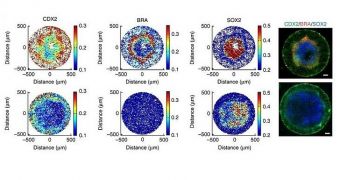Stem cell research may be controversial, since most HESC (Human embryonic stem cells) originate from embryos, but they are the key to many health advancements. 3D printing has just helped crack one of the biggest barriers in developing treatments based on them.
The breakthrough is owed to a team of researchers led by Ali Brivanlou, Robert and Harriet Heilbrunn, from the Laboratory of Stem Cell Biology and Molecular Embryology at Rockefeller University.
They haven't found an alternative source for stem cells (right now, they are obtained from destroying underdeveloped human embryos), but they did figure out something else: how to control the type of cells that stem cells turn into.
They haven't come even close to choosing exactly which of the 220 human cells the stem cells should turn into, but they did succeed in dictating which of the three primary germ layers they should become.
All 220 cell types grow from either ectoderm, endoderm or mesoderm cells. Previously, it wasn't possible to differentiate the areas in which the three germ layers were grown, because petri dishes lacked the chemical signals in the human body.
It normally works like this: chemical signals are sent to the HESCs through surrounding tissues, telling them where to form. In the lab, it's impossible to separate them in the proper orientation this way. Fortunately, 3D printing technology has provided the answer: not using chemical signals at all.
Instead, molds were created from an elastomer called PDMS (silicon-based Polydimethylsiloxane). It allowed the researchers to control the depth, diameter and shape of each HESC colony.
A side effect of the molds was that the HESCs grew and developed uniformly, meaning that when stimuli were introduced, the scientists could determine what type of cell each mold would grow. In the end, they were able to prompt the cells to distinguish themselves from one another, as well as control where each colonies would form.
All in all, while an alternate source for stem cells hasn't been discovered, every other big stumbling block has been surmounted now. Future stem cell therapies and regrowth of human tissue is now possible, though it might take years or decades for results to show.
In more layman terms, stem cells like to form patterns as they develop, and 3D printing technology allows to control which of those patterns takes precedence as the new colony develops. Soon enough there will be ways to remove scars entirely, regrow torn skin and muscles in days or hours, maybe even regenerate entire limbs, though that is still a long way off.

 14 DAY TRIAL //
14 DAY TRIAL //